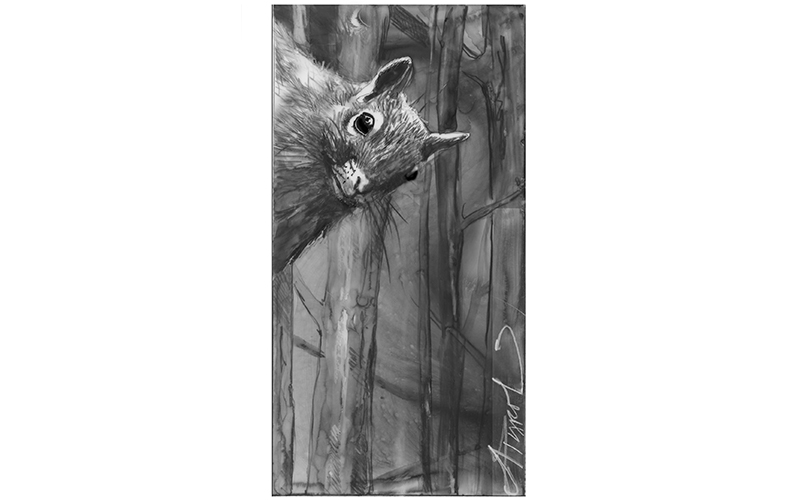Even if you’ve never ventured further into the forest than an urban park or a college campus, you’re probably familiar with Sciurus carolinensis, the eastern gray squirrel. While it’s easy to identify gray squirrels by sight; however, recognizing the various sounds they make is more complicated. Their vocalizations – squeaks, moans, buzzes, barks, and clucks – can sound like noises made by cats, chickens, jays, catbirds, even ducks.
The gray squirrel is one of two species of tree squirrels in the Northeast. The other, the red squirrel (Tamiasciurus hudsonicus), is more territorial than its larger cousin and is the more vocal of the two. In a mostly coniferous forest, the squirrel you hear chattering is likely a red squirrel, which feeds mainly on the seeds of evergreen trees. Gray squirrels are more common in mature hardwood forests or mixed deciduous-conifer forests, where they find tree nuts, holes for nesting, and a dense canopy to hide in.
Once I figured out that a gray squirrel produced the raspy meow I heard as I walked down a dirt road near my house, I began to wonder about the various sounds made by this species. What are these bushy-tailed acrobats communicating to me – and to each other?
In spite of how ubiquitous gray squirrels are, there has been surprisingly little study of their communication system, according to biologist Thaddeus McRae, of Lee University in Tennessee, who has studied gray squirrels in Florida, New York, and other locations. “The species has quite a varied repertoire of vocalizations, including a squeak similar to that of a mouse, a low-pitched noise, a chatter, and a raspy “mehr mehr mehr,” he said. These vocalizations are used to alert other squirrels, shoo predators away, and attract mates.
If you’re not big or scary-looking, one way to protect yourself is to make a lot of noise. Squirrels have it covered.
“They have three acoustically distinct alarm calls: kuks, quaas, and moans,” McRae said. “The most common sound by far is the kuk, which sounds like the bark of a very, very small dog. In fact, if you take a recording of a gray squirrel kuk and drop the pitch, it sounds just like a dog barking. It is usually repeated very rapidly for a few seconds, before slowing down.”
The quaa, on the other hand, sounds like a raspy meow – like the noise I heard near my house.
“Kuks and quaas are used to scare off predators and to warn other squirrels. Both are noisy, scratchy sounds with no clear note or tone,” McRae said. “In contrast, the vocalization known as a moan has a very clear tone, which usually quickly rises and slowly falls, sounding very like a sad person moaning. Quaas and moans sometimes blend into each other, and sometimes that makes them sound remarkably like a disgruntled chicken. Squirrels often use more than one call, but rapid kuks and quaas are most often given when a terrestrial predator is around, and moans are usually used in response to aerial threats like hawks.”
If you’ve watched gray squirrels for even a few minutes, you know they’re big tail-wavers. This, too, is part of their communication system, along with foot stamping and teeth chattering. Gray squirrels use both vocal and tail signals as alarms, but in McRae’s experience, tail flags are elicited by terrestrial threats such as a cat or a human. The rate of calls in a bout of vocal signaling also contains information about whether a threat is terrestrial or aerial.
Besides alarm calls, gray squirrels make a cooing or purring sound biologists call the muk-muk. Sometimes described as sounding like a stifled sneeze, this noise is used as a contact sound between mother and kits, and by males when courting females, according to McRae.
There is much still to learn about squirrel communication, including whether there are regional variations, as is the case with some songbirds. “Some bird species sing higher pitched songs in cities than in rural areas. It seems to help them to be heard over background noise,” said McRae. “Do city squirrels do something similar? If they do, it opens up a whole box of other questions. Do the vocalizations shift randomly in tone or speed, or is there some predictable trend?”
Whatever the intricacies in their communications, I enjoy watching – and listening to – these animals as they chase one another around, squirrel away acorns, and tell me to get lost.
Laurie D. Morrissey is a writer who lives in Hopkinton, New Hampshire. Illustration by Adelaide Murphy Tyrol. The Outside Story is assigned and edited by Northern Woodlands magazine and sponsored by the Wellborn Ecology Fund of the New Hampshire Charitable Foundation: www.nhcf.org.












